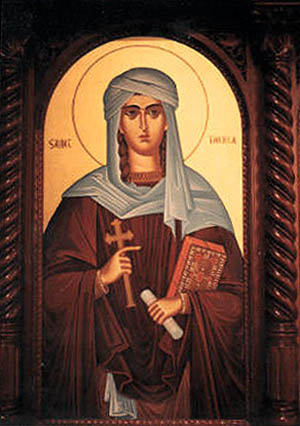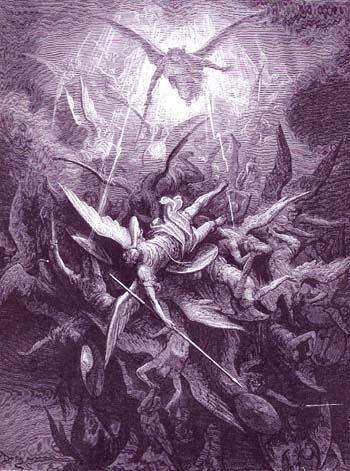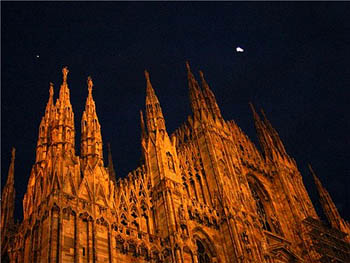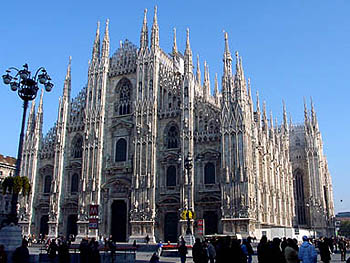 |
The Saint of the Day
St. Thecla, September 23
Prof. Plinio Corrêa de Oliveira
Biographical selection:
St. Thecla was considered by St. Isidore of Pelusium as the first woman martyr and one of the most beautiful ornaments of the century of the Apostles.

After submitting to tortures for the Faith and escaping unharmed, St. Thecla lived an ascetic life in Syria
|
St. Methodius of Olympus wrote in The Banquet of the Virgins that she had great knowledge in profane philosophy as well as literature. He also stated that she expressed herself with strength and eloquence, as well as sweetness and affability. She was converted by St. Paul and became knowledgeable in our religion. He praised her love for Jesus Christ, which she demonstrated on countless occasions, principally in her combats for the Faith.
According to St. Augustine, St. Epiphanius, and St. Ambrose, she was converted in Iconium (present day south central Turkey) by St. Paul in the year 34. Particularly inspired by his preaching on chastity, she determined to remain a virgin. She suffered tremendous pressures from her relatives and fiancé who were opposed to her conversion. But neither tender words nor threats could move her from her decision. St. Thecla realized that those who were closest to her were, in fact, acting as instruments of evil and thus avoided them as enemies of the Catholic cause. Nonetheless, their insistence constituted a true persecution.
She was denounced as a Christian to the authorities by her mother. She was tied to a stake to be burned, but the flames were put out by rains from Heaven before she was even touched by them. She was released by the embarrassed governor with orders to leave Iconium.
She went to Antioch in Syria, and there she was denounced by an admirer whose advances she refused. When she was offered to the beasts in the arena, they lay down at her feet without touching her. After other failed attempts to kill her, Thecla was released again. She spent the rest of her life as an ascetic, removed from the world. She died and was buried in Syria.
Under the first Christian Roman Emperors, a basilica was built over her tomb and became a site of countless pilgrimages. The Cathedral of Milan was dedicated to St. Thecla. Many pray to her asking to obtain a good death.
Comments of Prof. Plinio:
The presence of persecutors against St. Thecla among her very relatives and fiancé shows how vigilant we should be regarding enemies, and offers us a theme for meditation.

One category of devils were condemned straight to hell, and the other to remain in the air until the end times
|
First, you certainly recall that in the battle of the angels against the devils at the beginning of History, there were two categories of devils. Some clearly rebelled against God; others just allowed themselves to be dragged along by the first ones.
God condemned them all, but the first ones were sent straight to Hell, while the second ones remained wandering in the air until the end times, when they also will be sent to Hell. The devils of Hell are the ones who invite man to sin, and the devils of the air are the ones who predispose man in different ways to succumb to the temptations.
Second, this division of devils is quite accurate psychologically and also applies to evil men. If you analyze the ensemble of evil men, some are the torch bearers of evil, while there are others who just allow themselves to be dragged along by the first type.
Third, for us, who have given our lives to fight for the victory of Our Lady over the Devil, it is relatively easy to see the evil of the first kind of man, since they are bold and blatant revolutionaries. But it is not so simple to see the evil of the second kind. Since they are soft people who follow the Revolution out of weakness and allow themselves to be dragged along rather than take initiative as leaders, we have a natural tendency to be indulgent with this second type. Many times we think that these persons are, deep down, good individuals. We are mistaken. This judgment is equivalent to that of someone who would say that the devils of the air are also good. No, they are not. They clearly sided with the bad party, and for this reason were condemned by God. An analogous criterion applies to men, even though they will only be judged at their deaths.
What is the reason for this? If a man, habitually and without remorse, follows evil and forms a common front with the worst enemies of the good cause, then he is bad. He has hatred for someone who converts and begins to truly serve Our Lady and Our Lord. So, even if such persons know how to disguise their sentiment well, at heart they hate the Catholic cause. We should be vigilant when facing them.
You can see a confirmation of this in the life of St. Thecla. She was a prominent person in her city. She had great culture in an epoch when culture was a factor of prestige, almost as prestigious as being a movie star or good football player is in our days. She had her relatives and a fiancé to support her.
As soon as she converted she realized that she should avoid those very persons who had been close to her before. Why? Because she probably noticed that they were firmly rooted in the ways of evil and would not convert. She was right. For it was her relatives who tried to make her renounce her faith. Her own mother was the one who denounced her before the pagan authorities to be tortured and killed.

The Duomo of Milan was dedicated to St. Thecla

|
After she moved to Antioch the text reports an admirer who made advances toward her. Was he her betrothed from Iconium? If so, the man would have had to journey in pursuit of her only to denounce her in Syria, as her mother had done in Iconium. Today many people would say that he was in love, and that he only denounced her as an act of despair over her refusal.
To say he loved her is fallacious. The true sentiment that was inspiring him was egotism and hatred for the Catholic cause. St. Thecla resisted, and he denounced her as a Catholic, a denunciation that would result in her death. You can see how deep was his hatred, which appears to many as love.
She suffered many tortures. The text doesn’t make a full description, but such torments usually took place in large amphitheaters, or circuses, with great numbers of persons watching. Even from the brief description given, one can see that many miracles were made by God to preserve her and keep her alive and unharmed.
The selection does not indicate that there were any other conversions among those who witnessed the miracles. That is, all those people concurred with her mother and her admirer. Since they saw all the miracles God made to save her but didn’t care about them, those people were also bad.
She was saved miraculously and released, and she spent the rest of her life separated from the world. She renounced everything she could normally expect in life in order to serve the Catholic cause. She understood the hostility of the world and because she was vigilant, she was victorious over it.
I believe it is very important to ask St. Thecla to help us have the same understanding and vigilance, because in our fight, one of the most difficult obstacles to overcome is to see the bad side of the second type of evil men – the ones who are being dragged along by the Revolution and can appear to be good.


  | | Prof. Plinio Corrêa de Oliveira | |
The Saint of the Day features highlights from the lives of saints based on comments made by the late Prof. Plinio Corrêa de Oliveira. Following the example of St. John Bosco who used to make similar talks for the boys of his College, each evening it was Prof. Plinio’s custom to make a short commentary on the lives of the next day’s saint in a meeting for youth in order to encourage them in the practice of virtue and love for the Catholic Church. TIA thought that its readers could profit from these valuable commentaries.
The texts of both the biographical data and the comments come from personal notes taken by Atila S. Guimarães from 1964 to 1995. Given the fact that the source is a personal notebook, it is possible that at times the biographic notes transcribed here will not rigorously follow the original text read by Prof. Plinio. The commentaries have also been adapted and translated for TIA’s site.
|
Saint of the Day | Home | Books | CDs | Search | Contact Us | Donate

© 2002- Tradition in Action, Inc. All Rights Reserved
|
 |

|